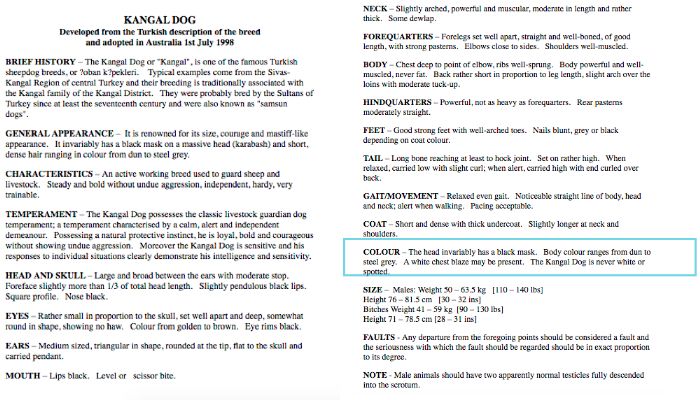
Anatolian Shepherd Dog - Kangal Dog
RATIONALE FOR CHANGE OF BREED STANDARD
From: FCI ANATOLIAN SHEPHERD DOG - FCI KANGAL SHEPHERD DOG
To: ANKC KANGAL DOG
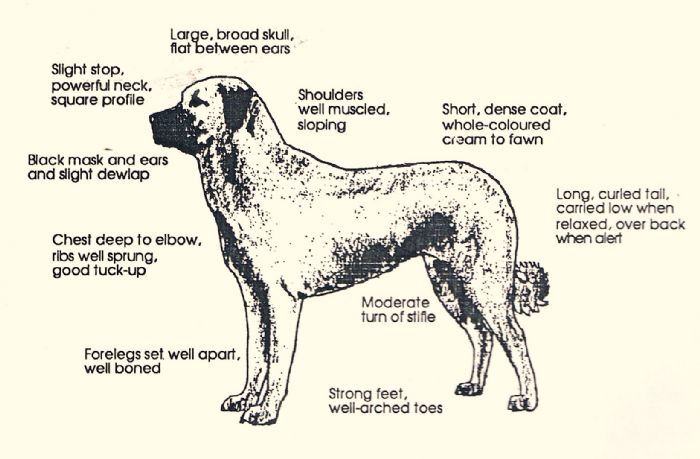
KC Anatolian Shepherd Dog
Breed Standard for the Anatolian Shepherd Dog in Australia 1987 - 1995
- Overview
- Summary
- ANKC is Country Of Development
- Justification for Kangal Dog colour amendment
- Splitting the breed into Kangal and Anatolian
- Kangal Dog breed development
- Chronology of the Anatolian / Kangal breed standard in Australia
- Takas Volkodav homepage
FCI Standard No. 331 is the current breed standard for Anatolian Shepherd Dogs in Australia.
In June 2018, FCI Standard No. 331 Anatolian Shepherd Dog was renamed to Kangal Shepherd Dog, and the breed standard content was revised. All FCI Anatolian Shepherd Dogs are now FCI Kangal Shepherd Dogs.
The breed name change to Kangal Shepherd Dog is not an issue for the majority of owners in Australia. The problem is the revised FCI Standard does not describe the majority of owners’ dogs (the significant difference is colour).
ANKC’s solution to recognise Anatolian Shepherd Dog as a separate breed to Kangal Shepherd Dog will ostracise Anatolian Shepherd Dog breeders from their main genetic exchange in FCI. ANKC previously split the breed in Australia from 1998-2011. The result was deleterious to the ostracised breed.
To mitigate the consequences of the 2018 FCI Standard revision, owners of the breed in Australia, request the breed change from the FCI Standard – Kangal Shepherd Dog, to the Country Of Development Standard - ANKC Kangal Dog with amendments, to allow for colour. The ANKC Kangal Dog standard is owned by the ANKC and therefore ANKC can make changes to the standard. Changing to the ANKC Kangal Dog standard will prevent disenfranchisement of Anatolian Shepherd Dog owners, and avoid deleterious outcome of a breed split.
- ANKC’s recognition of the breed in 1985 predates FCI (1989), AKC (1993) and the recognition of KIF (Turkish Kennel Club) as a Controlling Body (2010).
- ANKC is the first national recognised organisation to produce a breed standard for Kangal and accept registrations for the breed.
- ANKC Kangal Dog breed standard was recognised and registered in Australia in 1998 and adopted by NZKC (New Zealand Kennel Club) in 2002. FCI Kangal Shepherd Dog was recognised in 2018.
- ANKC National Breed Standards Committee definitions adopted in 2001, qualify ANKC as the Country Of Development.
- ANKC Policy on Adopting Breed Standards allows a breed to change from FCI Standard to Country Of Development Standard.
- ANKC procedure allows ANKC to make changes to breed standards owned by the ANKC.
- ASDCV’s request to change from FCI Standard - Kangal Shepherd Dog, to Country Of Development Standard - ANKC Kangal Dog with amendments, is supported by the breed’s registered history; NBSC definition of ‘Country Of Development’; ANKC Policy on Adopting Breed Standards, and ANKC Procedure for amending the breed standard for an Australian breed.
- The 2018 FCI Kangal Shepherd Dog breed standard disenfranchises owners of the breed because it is significantly different to the breed standards utilised in Australia since 1985.
- ANKC Kangal Dog breed standard has historical significance to the breed’s development in Australia and is written from the breed standards in use in Australia from 1985-1995. ANKC Kangal Dog was produced in Australia, to describe the breed in Australia, and 2018 amendments to allow for colour will prevent owners from being disenfranchised.
- Owners of the breed in Australia are entitled the option to determine the future of their breed and choose between FCI Standard – Kangal Shepherd Dog, or Country Of Development Standard – ANKC Kangal Dog with amendments.
- FCI and AKC, the organisations with the largest population of dogs, do not split the breed. The breed is simply registered according to the name of its Standard. ANKC Kangal Dog allows breeders in Australia to stay within this proven model.
- ANKC Code Of Practice For Breeders recognises Breed Clubs as ‘guardians of the breed’. This recognition is meaningless if ANKC does not heed advice from long time owners of the breed who have been through successive breed standards and a previous breed split.
ANKC is Country Of Development:
ANKC policy on adopting breed standards allows for owners of a breed to change from FCI Standard to Country Of Development Standard.
NBSC defines ANKC as the Country Of Development for the breed. The ANKC Kangal Dog breed standard is the first recognised standard for the breed, and was recognised and registered in Australia in 1998 and adopted by New Zealand in 2002.
FCI / KIF do not qualify as Country Of Development / Country Of Origin for the breed.
Definitions adopted by the NBSC in 2001:
COUNTRY OF DEVELOPMENT
Where a breed was established in a particular country, was never shown in that country at shows conducted under the auspices of a recognised Controlling Body, but then another Country produced a Breed Standard for the breed and accepted registrations for the breed.
COUNTRY OF ORIGIN - Definition Part 1
Where a breed was established in a particular Country, which has a recognised Controlling Body, and the same country produces the first recognised Breed Standard for that breed and accepts registrations for that breed.
COUNTRY OF ORIGIN – Definition Part 2
Where a Country, which has a recognised Controlling Body, establishes a breed with a Standard that is substantially different to the Standard of the Breed’s original country, and maintains a type that is generally accepted, by the majority of world recognised Controlling Bodies, as being the correct type, e.g. Dachshunds and Poodles
- ANKC - Australia is Country Of Development.
Australia is the first country to produce a breed standard and accept registrations for the breed. - ANKC Kangal Dog breed standard was produced in May 1997, and approved for recognition at the ANKC Conference in October 1997.
- ANKC Kangal Dog became a recognised and registered breed in Australia on 1st July 1998.
- NZKC recognised the Kangal in 2002 and adopted the ANKC Standard.
- KIF was recognised as a Contract Partner by FCI in 2010.
- KC recognised the Kangal in 2013 and produced its own standard.
- KIF became a Full Member of the FCI in 2017.
- FCI Kangal Shepherd Dog breed standard was produced and recognised in 2018.
- ANKC recognised and registered the Anatolian Shepherd Dog breed in February 1985 and utilised the pre1987 KC Anatolian Karabash breed standard.
- KC published its revised Anatolian Karabash breed standard as Anatolian Shepherd Dog in 1987 and ANKC adopted this standard.
- FCI recognised the Anatolian Shepherd Dog in 1989.
- AKC recognised the Anatolian Shepherd Dog in 1993.
- ANKC adopted the FCI Anatolian Shepherd Dog breed standard in 1996.
The implications of the breed’s registration history, is ANKC is Country Of Development.
Therefore owners of the breed are entitled the option to change from FCI Standard – Kangal Shepherd Dog, to Country Of Development Standard - ANKC Kangal Dog.
Justification for colour to be amended in the ANKC Kangal Dog breed standard
The first Anatolian Shepherd Dog breed standard in Australia did not allow all colours. Colour in the breed has evolved each time the ANKC adopted Standards for the breed.
1985-1987 (pre1987 KC ANATOLIAN KARABASH): A whole coloured dog of all shades of fawn. Characteristic black mask can vary from the desirable whole black head to just a black muzzle and dark ears. White socks and chest blaze commonly occur.
1987-1995 (KC ANATOLIAN SHEPHERD DOG): All colours are acceptable but it is desirable that they be whole colours, cream to fawn, with black mask and ears.
1996-2018 (FCI ANATOLIAN SHEPHERD DOG): All colours acceptable.
1998-2011 (ANKC KANGAL DOG): The head invariably has a black mask, dun to grey, white blaze on chest.
The reason for convergence and divergence over colour in the standards, is because colour has always divided breed enthusiasts. Historically colour and coat pattern in the absence of pedigrees was used as indicator of ‘purity’. Underpinning the breed’s development, breed name changes and colour amendments, was the belief that colour determined breed identity.
As Shepherd Dogs of Turkey did not have pedigrees, or a recognised registry (KIF formed in 2010) statements about colour were the yardsticks for ‘purity’. Hence ideas such as purebred Kangals do not have excess white;, black mask indicates purity, black nails further indicate ‘pedigree’, became the points of difference.
In Turkey, Kangal clubs have also been unable to decide on ideal colour. From 2010-2017 the KIF Kangal breed standard accepted brindle colour. In 2006 the FCI submission on Kangal suggested brindle, brindle and white, and black colour.
Essentially the difference between all the breed standards for Anatolian / Kangal is what colours are acceptable and how much white should or should not be allowed. The reality for owners of the breed in Australia is the overview that colour is not omni-important, and cannot be omni-important.
A colour amendment to 'All colours acceptable but it is desirable they be whole colours with a dark mask' is the appropriate colour clause for the breed in Australia.
A colour amendment can only be enacted under a change of Standard to ANKC Kangal Dog.
Splitting the breed into Kangal and Anatolian
ANKC ‘split’ the breed according to colour in 1998 with the simultaneous recognition of Anatolian Shepherd Dog (all colours) and Kangal Dog (fawn black mask only). The inevitable result was a reconvergence of the two breeds 13 years later in 2011.
A significant factor to the ANKC breed split failing, was one breed was ostracised from international recognition and could not import from its main genetic exchange in Europe and America. The second factor was the ostracised breed was then reliant on incomplete or blank pedigrees, which were prohibited for re-registration by ANKC Regulations. Logically if a breed is ostracized from genetic exchange, it fails.
Lessons learned from the ANKC Anatolian Shepherd Dog / Kangal Dog 1998-2011 breed split:
- Fawn black mask Anatolian Shepherd Dogs are impossible to distinguish from fawn black mask Kangal Dogs (hence why FCI Anatolian Shepherd Dogs = FCI Kangal Shepherd Dogs)
- ‘non standard’ recessive colours are impossible to select against in a geographically isolated population.
- Turkish Shepherd Dogs do not abide by colour restrictions imposed by their Standard. Kangal Dog Sivas Regals Pasha (IMP USA) is a prolific producer of pintos; imported Kangal Dog bitch Ayla (IMP DEU) produced liver and black and tan; and an ‘invariably black mask’ is difficult when the most prominent female line in Australia is based on a hardy fawn bitch with no mask, Iradene Winsome, from the first litter born in Australia.
- Breed splits over breed name and ideal colour result in attrition.
The breed split from 1998 – 2011 had catastrophic consequences for Anatolian Shepherd Dogs and Kangal Dogs in Australia. Due to the majority of dogs being rural and farm working dogs, and not active in conformation shows, ANKC and the broader pedigree dog community did not see the decimation of the breed, and the collapse of a vibrant breed community.
The two waves of imports for the breed, 1985 - 1997 and 2010 - 2017, coincide with the beginning and end of the 1998-2011 ANKC breed split.
Imports ceased in 1997 because breeders could no longer see a future in the breed, and breed entrants diminished because the breed(s) they encountered were in a dysfunctional state. Breed splits disenfranchise breeders because the pedigree history of the breed, which underpins a breeder’s connection to it, is erased.
Registries enact breed splits for Anatolian and Kangal because on paper it seems like a simple solution and the consequences are unseen.
The experience and reality for owners is breed splits solve problems in theory, but destroy breeds in actuality.
FCI and AKC (American Kennel Club) - the organisations with the largest population of dogs - do not ‘split’ the breed. Each registers the breed as one population according to the Standard in use.
FCI Anatolian Shepherd Dogs = Standard No. 331 = FCI Kangal Shepherd Dog.
AKC re-registers FCI Kangal Shepherd Dogs as Anatolian Shepherd Dogs.
ANKC re-registers Kangal Shepherd Dogs as Anatolian Shepherd Dogs (2011 to June 2018).
KC (The Kennel Club England) is the only recognised organisation actively registering Anatolian as a separate breed to Kangal - however KC re-registers imported Anatolian Shepherd Dogs with blank pedigrees (unverified parentage). Unless ANKC change its Regulations to allow imported Anatolian Shepherd Dogs with blank pedigrees to be re-registered, a ‘breed split’ model is futile.
ANKC breed split model failed after 13 years. The KC breed split model has been in effect for 5 years – since 2013 – prior to FCI Standard revision to Kangal Shepherd Dog. From June 2018 the KC Anatolian Shepherd Dog breed is ostracised from its established genetic exchange in FCI. The 2019 Crufts breed billing of both Turkish Kangal Dog and Anatolian Shepherd Dog is NOT an indication of success for KC’s breed split. The indication for success of the KC breed split is the number of registrations for the breed. There is one active KC Anatolian Shepherd Dog breeder, and the average yearly registrations since 2014 is 8 (KC Registration statistics 2014-2017). It is not likely the KC Anatolian Shepherd Dog will have a future beyond the short term. It is not likely the KC Anatolian Shepherd Dog will attract new breed participants. KC breed split model has produced an outcome where Anatolian Shepherd Dog owners have nowhere to go but out of their hobby.
In Australia the breed has only thrived under the ‘one breed’ model of FCI and AKC.
For more information on the 1998-2011 ANKC breed split with photos of Kangal puppies and Kangal dogs see Making Anatolians into Kangal Dogs: The Australian Outcome and Experience
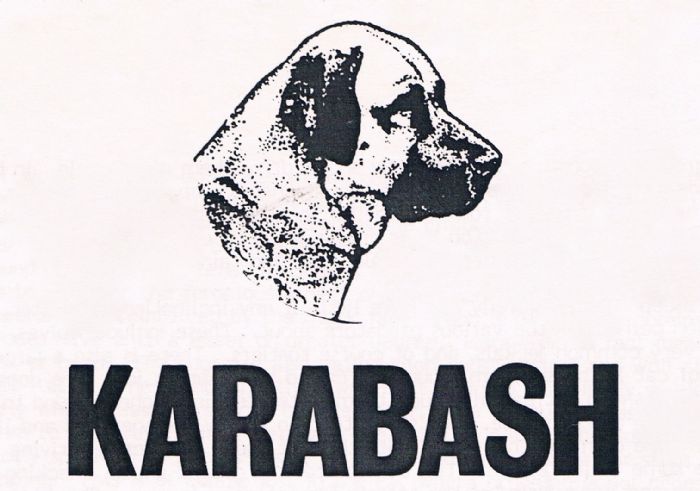 ANKC Kangal Dog has historical significance to the breed’s development in Australia, and is based on the breed standards in use for Anatolian Shepherd Dogs in Australia from 1985-1995: the Anatolian Karabash, and the KC Anatolian Shepherd Dog breed standard.
ANKC Kangal Dog has historical significance to the breed’s development in Australia, and is based on the breed standards in use for Anatolian Shepherd Dogs in Australia from 1985-1995: the Anatolian Karabash, and the KC Anatolian Shepherd Dog breed standard.The breed name which introduced the dogs to Australia in 1985 and marketed them as stock protection dogs for sheep and goat farmers was 'Anatolian Karabash'. Karabash is still used as the breed name by older generation farmers to identify their dogs today.
Karabash, from the Turkish kara and baş, translates to ‘black head’, and is one of several traditional descriptive names for Turkish Shepherd Dogs. In ideological terms, ‘Anatolian Karabash’ was the precursor to Kangal Dog.
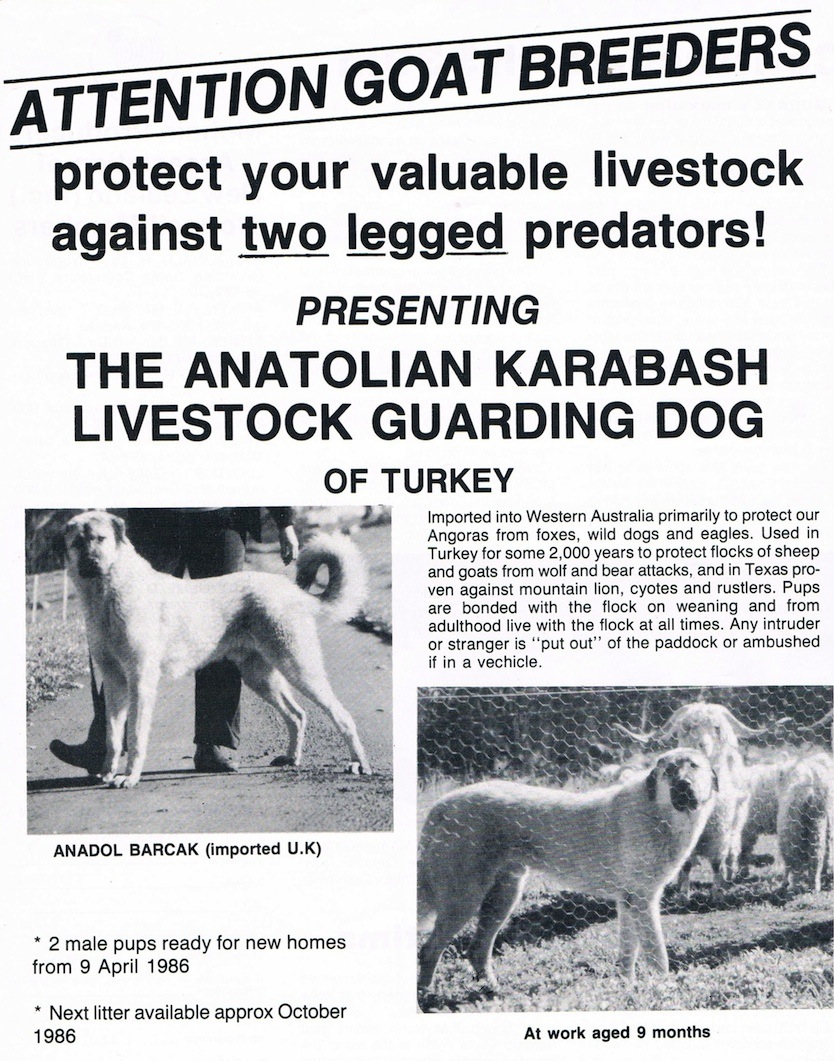 The first foundation dogs imported to Australia were from 'Anatolian Karabash' breeders in England. The KC (The Kennel Club England) breed standard for Anatolian Karabash, later revised and published as Anatolian Shepherd Dog in 1987, did not amend its colour description until 2005. From 1987 until 2005, Anatolian Shepherd Dogs in England had the colour description preference for a black mask, and whole coloured fawn dogs. Rough coats (longer coated Anatolian Shepherd Dogs) have always been excluded in the KC Anatolian Shepherd Dog by the phrase: 'No feathering on ears or legs.' From 1985 to 1987 Anatolian Shepherd Dog breeders in Australia followed the Anatolian Karabash ideal, and then in 1987 the Kennel Club breed standard for Anatolian Shepherd Dog. The change to the FCI standard which allowed rough coated dogs and all colours without mention of a black mask was a significant change for the breed in Australia, and in the 1990s, it was believed that rough coats, pintos (excess white), and the lack of a black mask were indicators that the dog was not 'pedigree'.
The first foundation dogs imported to Australia were from 'Anatolian Karabash' breeders in England. The KC (The Kennel Club England) breed standard for Anatolian Karabash, later revised and published as Anatolian Shepherd Dog in 1987, did not amend its colour description until 2005. From 1987 until 2005, Anatolian Shepherd Dogs in England had the colour description preference for a black mask, and whole coloured fawn dogs. Rough coats (longer coated Anatolian Shepherd Dogs) have always been excluded in the KC Anatolian Shepherd Dog by the phrase: 'No feathering on ears or legs.' From 1985 to 1987 Anatolian Shepherd Dog breeders in Australia followed the Anatolian Karabash ideal, and then in 1987 the Kennel Club breed standard for Anatolian Shepherd Dog. The change to the FCI standard which allowed rough coated dogs and all colours without mention of a black mask was a significant change for the breed in Australia, and in the 1990s, it was believed that rough coats, pintos (excess white), and the lack of a black mask were indicators that the dog was not 'pedigree'.ANKC Kangal Dog (1998) came about from Anatolian Shepherd breeders in Australia who were opposed to the change of standard from KC (which was based on Anatolian Karabash ideals, ie must have a black mask) to FCI, which allowed all colours, and did not place emphasis on the ‘characteristic black mask’. Ironically, far from proving Kangal is a distinct breed from Anatolian because the Kangal breed 'always breeds true' (ie the Kangal has a black mask and is never white spotted), the ANKC Kangal Dog breed split demonstrated unequivocally that 'colour' is not an indicator of pedigree. Under scrutiny of a registered breed population with generational record it became apparent that rough coats, excess white, recessive liver and black tan, and no black mask, was not the bane of 'mixed breed' Anatolian Shepherd Dogs - Kangal (Karabash black head) x Akbash (white head) x Kars (long coat) - but the genetic reality of a Turkish Shepherd's guardian dog with the Agouti allele.
During the breed’s early registry years, it would be anathema for Anatolian Shepherd Dogs (dogs with ‘impure’ coat indicators) to be Kangal Shepherd Dogs. From 1998 to 2011 the separate breed recognition of Kangal Dog in Australia demonstrated colour was not crucible to breed identity. Rather more importantly, the function of the dogs - their ability to do their job as guard dogs of livestock on farms in Australia - was paramount to their breed identity as 'guard dogs for sheep and goats, hard working, capable of enduring extremes of heat and cold'. Unlike the Kennel Club England, Australia's utilisation of the dogs is largely in rural working homes, either as bonded dogs to stock or roaming farm guardians on expansive allotments of land. Owners of the breed in Australia arrived at the 2018 classification conclusion of FCI and Turkish Kennel Club, in 2011: Anatolian Shepherd and Kangal are alternative breed standard names for the same population of dogs. Since 2012 the breed in Australia has thrived, and Australian dogs are exported to all main registries FCI, AKC, NZKC as breeding stock . The breed in Australia is esteemed for its hardy breed type and preservation of working ability, developed from outdoor Australian conditions, by Austraian breeders, and ANKC registry outcomes since 1985.
In 2018, FCI Anatolian Shepherd Dog = FCI Kangal Shepherd Dog, is a practical solution for the breed in Europe to integrate FCI's new member Turkey into their studbooks.
Likewise in 2018, a change of Standard to Country Of Development Standard - ANKC Kangal Dog, is a practical solution for the breed in Australia, and gives stewardship of the breed to the owners and registry, which registered the breed first:
ANKC was the first recognsed registry to produce a Kangal breed standard and register Kangal as a breed (1998) and the first registry to classify registered Kangal and registered Anatolian Shepherd as one breed population. ANKC actioned the ‘one breed population’ model in 2012. FCI and the Turkish Kennel Club actioned the ‘one breed population’ model in 2018.
Australia’s expansive sheep and goat enterprises has contributed to the breed’s acceptance as a livestock guardian dog beyond the borders of Turkey, and developed its breed identity as a guard dog of livestock and farm assets for agricultural industry.
The Karabash was imported for the Australian Farmer to increase the lambing rate ... Because of the size of Australian Farmers' properties they are unable to check the ewes day and night. The use of the guarding dogs should see this lambing rate increased greatly with the foxes and domestic dog packs unable to penetrate the paddocks.
Sue Freshwater, RANSU, 1985
The Anatolian Karabash has a big future in Australia not only protecting sheep from predators but guarding valuable livestock against thieves.
Dean Beynon, IRADENE , 1985
The breed’s identity as a guard dog of farm assets, and the breed’s primary utilization as a working dog in Australia, is the result of extensive promotion by breeders to establish the breed as a successful livestock guardian dog in Australia, and breeders’ efforts to breed a dog suited to Australian working conditions and which met Australian farmers’ requirements.
The working conditions and requirements of the dogs in Australia and the livelihoods and assets of Australian farmers, are very different to the generally impoverished Shepherd in Turkey and his herd of goats and sheep. Australian farmland is fenced, and the dogs are required to protect valuable assets against four and two legged threats.
“Anatolian Karabash Guard Dogs. Guarding sheep cattle, goats, deer, poultry, ocean vessels, persons and property etc
Against: predators (dingoes, wild dogs, foxes, eagles), stock thieves, trespassers and raiding wild life (kangaroos etc)”
1986 breed promotion
In 2018 the dogs are utilised to protect diesel fuel lines in outback Australia and silos of grain supplies for export. They are employed to guard and watch over cattle and sheep intended for live export and have differentiated into guard dogs of large free range chicken flocks (up to 30,000 birds) to protect against wedge tail eagles and foxes. They live out with their stock unassisted and rely on automatic feeders; hardy constitution and good instincts nurtured by the breeder; and good training and rearing by the farmer.
Australian outdoor conditions, differential guard targets, and ANKC registry outcomes, have resulted in the breed population in Australia developing into a larger and more colour diverse dog than described by the 2018 FCI Kangal Shepherd Dog breed standard. The sheep and goat guard dog of the Turkish Shepherd has been developed into an imposing guard dog of livestock and farm assets for Agriultural and Farming Industry in Australia.
“It must be realised that the conditions under which Anatolian Karabash Dogs are utilised in their native Turkey, and the conditions under which they will have to work in Australia, are entirely different.
We are in fact asking a great deal more of them under paddock conditions, in Turkey they work in conjunction with a shepherd for most of the time.
In Australia, we will be expecting them to work in the field, without any supervision. They will also be expected to camp out at the mercy of the elements”.
Terry Page COOETONG 1985 - foundation Anatolian Karabash / Anatolian Shepherd Dog / Kangal Dog breeder.
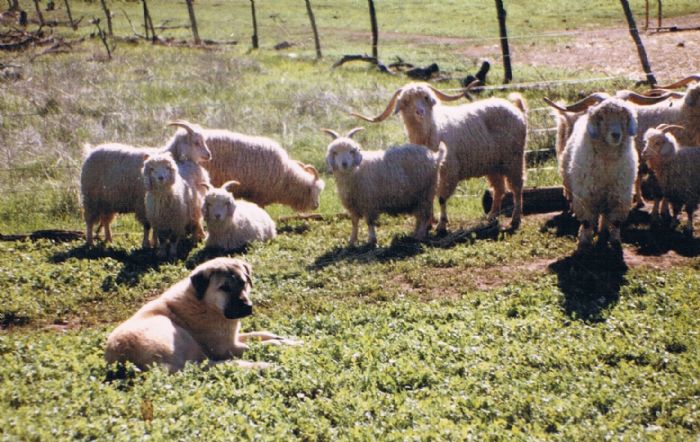
Anadol Barck (Imp UK) - July 1985 - first working Anatolian in Australia
Chronology of the Anatolian / Kangal Shepherd Dog Breed Standard in Australia
1. ANKC Breed Standard for Anatolian Shepherd Dog 1985 - 1987: pre1987 KC Anatolian Karabash
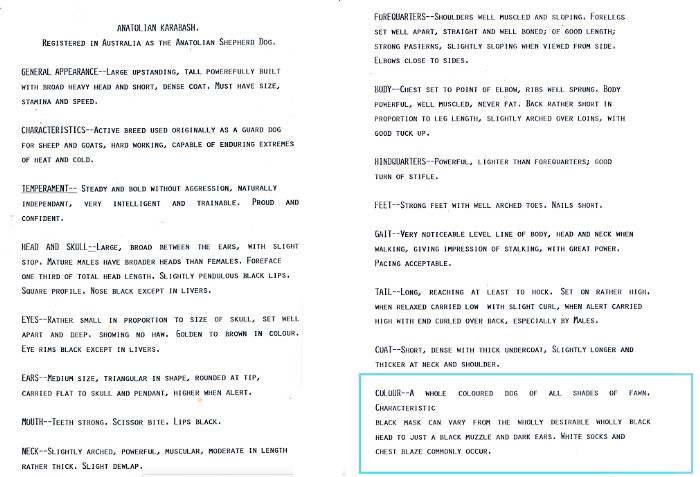
2. ANKC Breed Standard for Anatolian Shepherd Dog 1987 - 1995: KC Anatolian Shepherd Dog
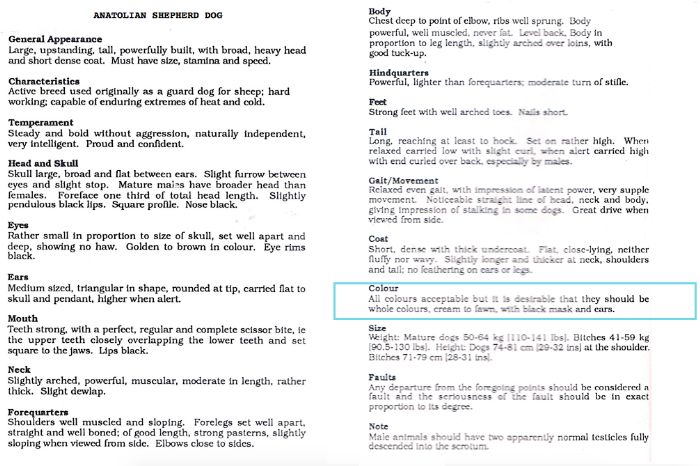
3. ANKC Breed Standard for Anatolian Shepherd Dog 1996 - 2018: FCI Anatolian Shepherd Dog
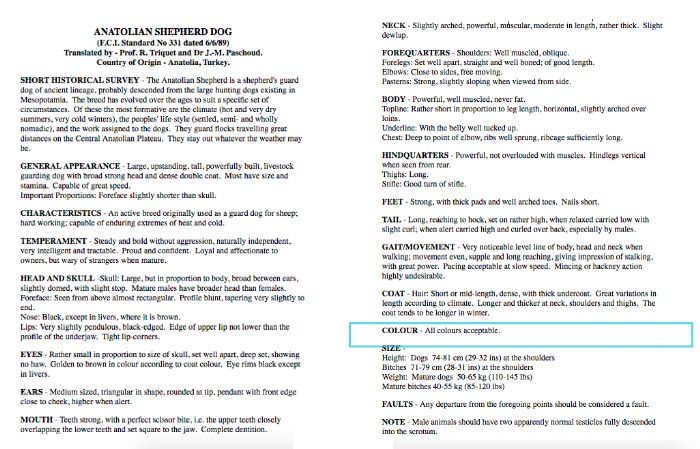
4. ANKC Breed Standard for Kangal Dog 1998 - 2011: ANKC Kangal Dog
